

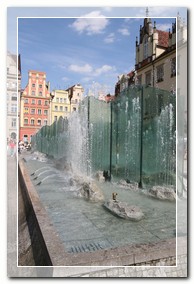
 very respected city has its market square. The one in
Wroclaw served already in the XIII century as a trading square, at the
beginning surrounded by wooden buildings, however already at the end of
the century with brick tenements. As on those times it was huge — it has
got 173 on 208 meters and is one of the largest markets in Europe. It
was also perfectly stocked — except regional products, such as honey and
dairy products sold in the neighborhood of the present pillory, or fish
and salt from the nearby Saline Square, one could buy here Italian
fabrics of marvelous beauty and exotic spices. Passing through Wroclaw,
Queen Marysienka was delighting in a letter to John III Sobieski, how
good the city is stocked and what beautiful things can be bought here.
Wroclaw also had two unusual municipal weights. The larger could
supposedly weigh goods up to 10 hundredweights, that is about 500 kg.
The legend says that in the result of a misunderstanding a rich, but
good and devout draper was forced to its foundation. He offered as a
gift on Christmas to all his journeyman beautiful dresses made of the
best fabric. To pay back they decided to escort him to the church as a
honorable guard. The city council did not understand this gesture
very respected city has its market square. The one in
Wroclaw served already in the XIII century as a trading square, at the
beginning surrounded by wooden buildings, however already at the end of
the century with brick tenements. As on those times it was huge — it has
got 173 on 208 meters and is one of the largest markets in Europe. It
was also perfectly stocked — except regional products, such as honey and
dairy products sold in the neighborhood of the present pillory, or fish
and salt from the nearby Saline Square, one could buy here Italian
fabrics of marvelous beauty and exotic spices. Passing through Wroclaw,
Queen Marysienka was delighting in a letter to John III Sobieski, how
good the city is stocked and what beautiful things can be bought here.
Wroclaw also had two unusual municipal weights. The larger could
supposedly weigh goods up to 10 hundredweights, that is about 500 kg.
The legend says that in the result of a misunderstanding a rich, but
good and devout draper was forced to its foundation. He offered as a
gift on Christmas to all his journeyman beautiful dresses made of the
best fabric. To pay back they decided to escort him to the church as a
honorable guard. The city council did not understand this gesture 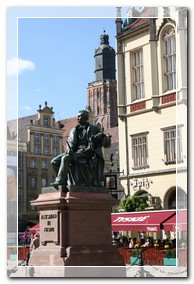 correctly, and in order to punish the
tradesfolk boasting in their opinion, ordered him to build the municipal
weight with his own resources. We can admire its dimensions even today,
though only foundations stayed after it - in the place, where it stood
formerly, a long on 11 meters modern fountain made of glass and stone
was raised. From the originator's surname, contemporary president of
Wroclaw Bogdan Zdrojewski it is called often Zdroj (the source).
correctly, and in order to punish the
tradesfolk boasting in their opinion, ordered him to build the municipal
weight with his own resources. We can admire its dimensions even today,
though only foundations stayed after it - in the place, where it stood
formerly, a long on 11 meters modern fountain made of glass and stone
was raised. From the originator's surname, contemporary president of
Wroclaw Bogdan Zdrojewski it is called often Zdroj (the source).
In the year 1956 in front of the Town Hall in the place where the
statue of Frederic Wilhelma III was situated, a monument of Alexander
Fredro brought from Lviv was placed. This is the favorite place of
appointments for lovers. In 1988 the pillory removed briefly after the
war near the eastern elevation of the Town Hall was reconstructed -
today it is only a decoration, however since the moment of building in
1492 till the XVII century thieves, wranglers and drunks were tied up to
it and put on the public eye. This was also the place where courts under
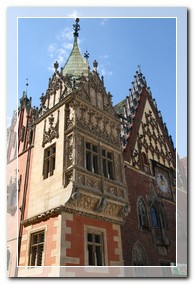 the naked sky took place. Supposedly it was
the Wroclaw's pillory, where once even the famous sculptor Wit Stwosz
was judged, who around the year 1500 stopped in the capital of Lower
Silesia. He did not lead a successful life in that times, he fell in
financial trouble and brought to the necessity he counterfeited a
promissory note. By the decision of the court he had to spend one year
in the prison on the present Prison St.
the naked sky took place. Supposedly it was
the Wroclaw's pillory, where once even the famous sculptor Wit Stwosz
was judged, who around the year 1500 stopped in the capital of Lower
Silesia. He did not lead a successful life in that times, he fell in
financial trouble and brought to the necessity he counterfeited a
promissory note. By the decision of the court he had to spend one year
in the prison on the present Prison St.
Today Wroclaw's market square presents itself so richly, that no one would have supposed, that during the war bombings and fires destroyed about 50% of it's historical buildings. My Father used to tell that after classes he had gone with different students to the market square to collect the fragments of the facades, which were numbered and used to the reconstruction of the Renaissance and neoclassical tenements. Some, like the tenement "Under the gold dog", were completely rebuilt on the basis of a photo (from the original tenement only the dog from the portal was preserved, miraculously saved in the cellars of the house, which is at present in the gatherings of the Museum of Architecture).
Except the beautiful Town Hall people's sight can be drawn by renewed
tenements of marvelous beauty. Near the market square since the 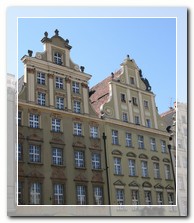 beginning of its existence
60 numbered estates stood, while some buildings possess several numbers.
Every land also possesses its historical name usually connected with an
attribute placed formerly on the elevation of the tenement or the fates
of the place, e.g. Under the Griffins, Under the Blue Sun, Old Town h
all.
beginning of its existence
60 numbered estates stood, while some buildings possess several numbers.
Every land also possesses its historical name usually connected with an
attribute placed formerly on the elevation of the tenement or the fates
of the place, e.g. Under the Griffins, Under the Blue Sun, Old Town h
all.
The most original, renaissance and mannerist tenements on the Gothic framework were preserved on the western side of the Market, called the Side of Seven Electors, which survived the bombings almost undamaged. Tenements of this frontage, belonging formerly to the most illustrious and the richest citizens of Wroclaw, possess very deep land parcels, measuring formerly 240 feet, reaching Kiełbasnicza street. What deserves special attention on this side of the market square is:
- the mannerist tenement "Under the Griffins" (no. 2) with an
unusually high top, concealing five-storey loft, about the facade
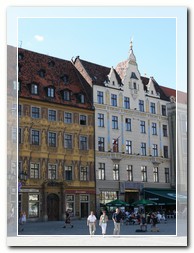 decorated with griffins
and other mythical creatures.
decorated with griffins
and other mythical creatures. - the late-baroque tenement "Under the Gold Sun" (no. 6), in which the Medal Art Museum is held.
- the tenement "Under the Blue Sun" (no. 7) There were problems with establishing who is the owner of the property, this is why the tenement was spoiling for a long time. At the end of the 90's it's courtyard, now the trade passage, was covered with a glass roof.
- the tenement "Under the Seven Electors", (no. 8) brings the attention with it's rich embellishments, illusionist paintings and an exquisite portal with an imperial eagle, reconstructed at the beginning of the 90's with techniques used in the XVII century.
The building on the corner of the Market square and the Saline square containing today the Western Bank is also a historical building, made in 1931.
The south side, carrying formerly the name “Side of the Gold Cup”,
and long ago the “Old Gallows” suffered particularly 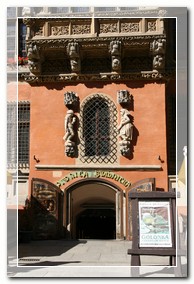 in the result of war
destructions. Its buildings constitute in a considerable degree a
reconstruction made in the years 1952-1960. Special attention, while
should be paid to:
in the result of war
destructions. Its buildings constitute in a considerable degree a
reconstruction made in the years 1952-1960. Special attention, while
should be paid to:
- the tenement "Under the Gold Pitcher" (no. 22), which facade was reproduced according to the form from 1822. On its yard a famous beer, the White Aries was produced, which then was transported with a tunnel to the Swidnicka Cellar.
- the tenement "Under the Green Pumpkin" (no. 23), rebuilt in a Renaissance style.
- the tenement "Under the Gold Cup"(no. 26). There is a stone plate on its yard from 1529 presenting the Christ in Pain. Special attention on this side also should be paid to an unusually beautiful elevation of the town hall and the famous Swidnicka Cellar, the World’s oldest restaurant.
In the eastern frontage, called some time ago the Side of the Green Reed, special attention should be paid on two buildings:
- A store house built in 1904 (at present Feniks, no. 31–32) , with
an exquisite art nouveau elevation. It was crowned by a huge globe,
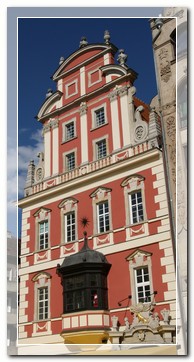 which however was burnt after being hit by
lightning.
which however was burnt after being hit by
lightning. - the tenement "Under the Gold Dog" (no. 41), the last rebuilt tenement of Wroclaw's market. During the siege of the city in 1945 it was severely damaged, then in the next years it was knocked down; only the cellars and the portal were preserved. On the basis of plans and photos a building reconstructing the external forms of the former tenement was raised, however realized in the present reinforced concrete construction. The works were finished in 1994.
On the northern side of the market, formerly carrying the name Side of the Market of Sweets, one original baroque tenement was preserved under the number 46, and a Renaissance column from 1540 in the interior of the tenement "Under the Gold Anchor" (no. 52). The rest of the buildings on this side of the Market was destructed and well reconstructed on the basis of the kept plans, prints and photo. This part of the Market is particularly adorned by the tenements:
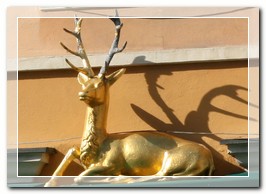 The Chemist's Under the
Double Gold Eagle (no. 42)
The Chemist's Under the
Double Gold Eagle (no. 42)- The Tenement Under the Gold Pelican (no. 43)
- The Tenement Under the Gold Deer till the XVII century called the Drugstore of the Market of Sweets (no. 44)
It is also worth to mention the buildings on the centre of the market adhering to Wroclaw's Town hall. The intermarket block was composed of the Tradesfolk house (The Cloth Hall), the smatruz (in which bread and footwear was traded) and the house of linen, the Rich Stalls, the Linen Stalls and the Small and the Great House of Weight.
























